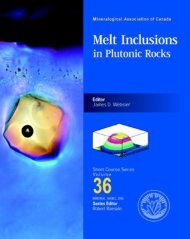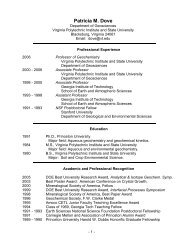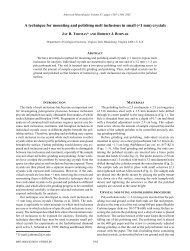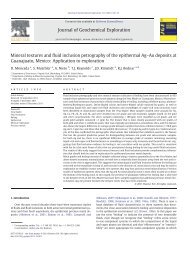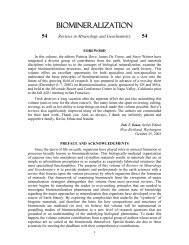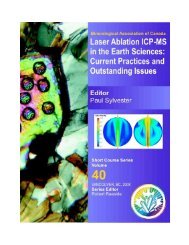Biomineralization Within Vesicles: The Calcite of Coccoliths
Biomineralization Within Vesicles: The Calcite of Coccoliths
Biomineralization Within Vesicles: The Calcite of Coccoliths
Create successful ePaper yourself
Turn your PDF publications into a flip-book with our unique Google optimized e-Paper software.
<strong>Biomineralization</strong> <strong>Within</strong> <strong>Vesicles</strong> 201the radial direction in proximal view. This chirality is related to departures <strong>of</strong> thenucleation orientations from simple orthogonal radial and vertical directions, i.e., thenucleation is chiral (Didymus et al 1994; Young et al. 1999).Thus, heterococcolith rim nucleation is characterized by a suite <strong>of</strong> features:alternation <strong>of</strong> c-axis orientations, control <strong>of</strong> a-axis orientations, stability throughevolutionary history and chirality. This very precise nucleation control can most easily beexplained in terms <strong>of</strong> control from a macromolecular template substrate. <strong>The</strong> principalalternative would be random nucleation followed by selection <strong>of</strong> favorably orientednuclei, but this should only lead to selection <strong>of</strong> c-axis directions, as is seen in many otherbiomineral systems, not total crystal orientation, which is much more rare. Similarly,chirality is a predictable result <strong>of</strong> nucleation on a biochemical substrate since virtually allorganic macromolecules are chiral and occur in natural systems as only oneenantiomorph. <strong>The</strong>refore, a plausible model for the precise nucleation control around themargin <strong>of</strong> the organic baseplate is that a belt <strong>of</strong> macromolecular substrate occurs in thisposition with arrays <strong>of</strong> potential binding sites for calcium or carbonate ions whichpromotes nucleation <strong>of</strong> oriented calcite crystallites. Young et al. (1992, 1999), and Marsh(1999) speculated on possible geometries <strong>of</strong> such a template that could result in the V/Rpattern <strong>of</strong> evolutionarily stable alternation <strong>of</strong> nucleation directions.This hypothesis is tempting, but it has not been substantiated by direct evidence.Furthermore, although all heterococcoliths appear to have rims conforming to the V/Rmodel, additional, separately-nucleated crystals that do not fit this model <strong>of</strong>ten occur inthe central area <strong>of</strong> heterococcoliths. Ophiaster illustrates one rather common pattern, seenin numerous coccoliths produced by the families Syracosphaeraceae andRhabdosphaeraceae (Young et al. in press), an apparent pattern <strong>of</strong> V/R/T alternation. Thiswould require a more complex template but could still conform to the general model.Such coccoliths, however, also <strong>of</strong>ten have additional elements separate from the rim.<strong>The</strong>re are a few such elements visible in Ophiaster (Fig. 6C). A more extreme and verybeautiful example is provided by Rhabdosphaera (Fig. 7). Here the rim, with inferredV/R structure, is very narrow and encloses a large mass <strong>of</strong> lamellar crystal units and acentral spine <strong>of</strong> intergrown crystals (Kleijne 1992). <strong>The</strong> spine structure is remarkablyelegant, consisting <strong>of</strong> five interwound spirals <strong>of</strong> crystals (Fig. 7C). <strong>The</strong> componentcrystals <strong>of</strong> the spine show regular rhombohedral faces with perfectly regular alignmentspiraling up the structure. Evidently, nucleation here is not confined to the narrow beltaround the baseplate but occurs across the base and up the spine, still with regular crystalalignment and consistent chirality. If a template is involved, it is unclear where it islocated and it lacks the V/R alternation.GrowthRegulation <strong>of</strong> calcite growth by coccolithophores is almost as remarkable as theregulation <strong>of</strong> nucleation. <strong>The</strong> crystal units sketched in Figures 3 and 6 are each singlecrystals <strong>of</strong> calcite, and their shapes are radically different from that <strong>of</strong> inorganic calcite.However, such crystals do not exist in isolation, but are parts <strong>of</strong> the complete coccolith, andmuch <strong>of</strong> the morphology is a product <strong>of</strong> interaction between adjacent crystals. Further, it isclear from the cytological observations that there is no precursor matrix for the coccolith,but rather that the coccolith grows in an expanding vesicle. <strong>The</strong> final structure <strong>of</strong> thecompleted coccoliths to a large extent an emergent result <strong>of</strong> inorganic growth <strong>of</strong> thecrystals defined by the nucleation stage, within a space defined by the expanding vesicle.Because inorganic growth directions are utilized, the precise orientation <strong>of</strong> the calcitecrystal lattice in coccolith elements is important for developing morphology. Using atomicforce microscopy, we have investigated C. pelagicus and O. fragilis coccoliths from



